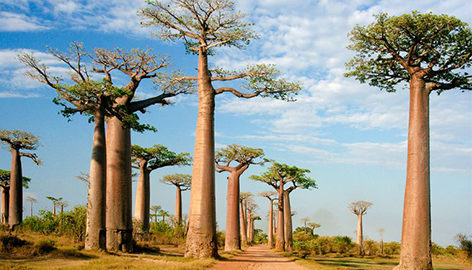

Welcome to yet another chapter of our series “Banknotes of the Countries from across the world”. Though banknotes by their very definition are a type of a negotiable promissory note, made by a bank, payable to the bearer on demand, they are artistic treasures in their own right. All the countries are no doubt proud of their history and heritage and proudly boast about them on their currency notes. Currency notes and their designs and reason behind their issuance are in itself a topic of great interest and study. Hence we will discuss various such interesting and unique banknotes of the world.
In this part we are going to look at the banknotes of Madagascar. To read the previous parts of the “Banknote of the world” series, click here.
Madagascar is a huge island nation off the southeast coast of Africa. Madagascar is a biodiversity hotspot; over 90% of its wildlife is found nowhere else on Earth. It is home to thousands of animal species, such as lemurs, plus rainforests, beaches and reefs. Near the busy capital, Antananarivo, is Ambohimanga, a hillside complex of royal palaces and burial grounds, as well as the “Avenue of the Baobabs,” a dirt road lined by massive centuries-old trees.
The island’s diverse ecosystems and unique wildlife are threatened by the encroachment of the rapidly growing human population and other environmental threats. Ecotourism and agriculture are key elements of Madagascar’s development strategy and the country belongs to the group of least developed countries, according to the United Nations. The main economic resources of Madagascar are tourism, textile export, production and export agricultural and mining.
Uptill January 1, 2005, the franc was the currency of Madagascar. It was subdivided into 100 centimes. In 1961, the Institut d’Emission Malgache (Malagasy Issuing Institute) introduced banknotes in denominations of 50, 100, 500, 1000 and 5000 francs.
The Ariary is the current currency of Madagascar and it is subdivided into 5 iraimbilanja and is one of only two non-decimal currencies currently circulating. The names Ariary and Iraimbilanja derive from the pre-colonial currency, with ariary (from the Spanish word “real”) being the name for a silver dollar. Iraimbilanja means literally “one iron weight” and was the name of an old coin worth 1/5 of an ariary.
Today we are discussing a few Italian Lire banknotes issued in various years. The note specifications are as follows:
5000 francs or 1000 Ariary banknote of 1995
This 5000 francs or 1000 Ariary banknote of 1995 issued by the Central Bank of the Republic of Madagascar boasts all the unique Malagasy features on it.
The reverse of the note has Ring-tailed lemur (Lemur catta); Diademed Sifaka (Propithecus diadema); Red Ruffed Lemur (Varecia rubra); Madagascar Pygmy-Kingfisher (Ceyx madagascariensis); Madagascar Fody (Foudia madagascariensis); Helmet Vanga (Euryceros prevostii); seashells; butterflies on it. The obverse portraits a Malagasy young boy with the Cane cutters, ox driven cart, abstract finial of a wooden Aloalo tomb sculpture and the massive centuries old Baobab trees in the background!
500 Ariary / 2500 Francs (1993)
The obverse has the portrait an older Malagasy woman in centre with plants to right. The reverse has wild animals and plants of Madagascar: like the Grey heron (Ardea cinerea), tortoise, Verreaux’s Sifaka lemur (Propithecus verreauxi), butterfly, plants. This multi-coloured banknote has a Zebu’s head as its watermark.
100 Ariary banknote (2004)
This banknote was issued by Banky Foiben’i Madagasikara/Central Bank of Madagascar in 2004.this banknote is printed in blue and tan on multicolored underprint.
The obverse of this note depicts denomination in words printed in Malagasy language at top centre and at top right in Roman script. The numerical denomination is printed at bottom left and right corners. The prefix and serial number are seen at top left corner and lower right with signatory of Governor above it. The Legend ‘Central Bank of Madagascar’ in Malagasy language is printed at bottom centre. Vignette of Ravinala and Tsingi plants at left.
The reverse of this note illustrates legend ‘Central Bank of Madagascar’ is printed in Malagasy language at top centre and year of issue at top left with text in Malagasy at left. The numerical denomination is seen at top left, right and lower left corners. The denomination in words printed in Malagasy script at bottom right corner. Vignette of mountain and trees printed at right and small map of Madagascar at upper left.
500 Ariary banknote of 1998
Obverse: Portrait of a Malagasy woman to centre-right; The Dotted Aerangis (Aerangis punctata) or Comet Orchids to centre left; View of Prime Minister’s Palace in Antananarivo in centre middle; Abstract finial of a wooden Aloalo tomb sculpture to extreme right.
Reverse: Malagasy weavers at work in centre; Madagascar Dragon Tree to left. This orange/red note has the Zebu’s head as its watermark.
Always wanted to visit this paradise?
“Ta-Daa!! Your wish has come true!” Book a ticket and go explore it for yourself or collect such awesome banknotes! Save our environment and go green! Hobbies help to gain knowledge. Notaphily is such a hobby that will give you knowledge of numerous countries and their currencies.
Indeed instead of just spending the money, just for once let’s appreciate the beauty of their designs. There are so many more such banknotes of the world and we are very excited to explore such wonderful artworks. Stay with us and let’s enjoy this together.
The Mintage World Team comprises of experts, researchers and writers from the field of Philately, Notaphily and Numismatics who try to shed light on some of the most interesting aspects of coins, banknotes and stamps from not just India but across the globe as well.